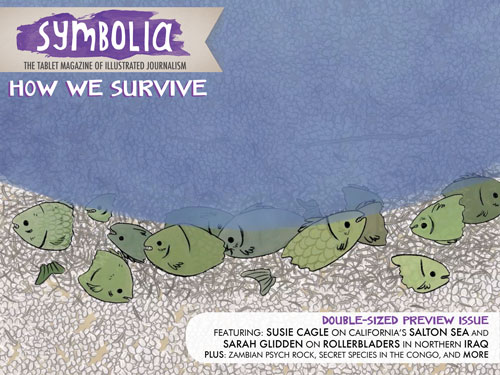After a decade in news, Symbolia co-founder and publisher Erin Polgreen is adjusting to startup life. And, judging by the vigorous press coverage, it’s not all bad.
Plus, there’s the actual work, which is also nice.
“Operating as a start up is great because we can change course quickly if we need to,” says Polgreen, who launched Symbolia last week. “There’s not a lot of weight or infrastructure holding us back.”
That ability to change course means that Polgreen and her team can get things done quickly, but could also wait a few months to push out the first issue of Symbolia in order to fine tune the user experience. The result: one of the signature pieces of the first issue, “Secret Species of the Congo,” got an upgrade that better merges the audio and visual elements.
Under normal circumstances, creating a piece for Symbolia is a multi-step process. Once Polgreen receives a pitch, she considers whether or not it fits within the Symbolia model (a timely, but not necessarily time sensitive, issue that encompasses a general issue within the story of a more specific person or place). Once accepted, Polgreen assigns it to a reporter who ideally reports the story alongside an artist, who takes notes and reference photographs with the goal of keeping the art true to life.
Both parties return to Polgreen with thumbnails and a rough script for the piece. In exchange, Polgreen gives valuable feedback about the narrative flow and illustrative overlap.
“I ask my artists to be as representational as possible without losing their signature style,” says Polgreen. “We are not creating caricatures we are representing individuals.”
The writer and the artist employ the critiques and come back with a more polished version that then goes through a line editing and fact checking process.
The final stage of constructing a story is incorporating the interactive elements. According to Polgreen, this is where her co-creator and creative director Joyce Rice comes in. The interactive aspect must fall within the look and feel of Symbolia, a very specific vision that Rice has developed — ideally using audio, music, and animation to help tell the story.
The real challenge, though, is finding the fiscal resources to fund the project. Charging $2.99 per issue and $11.99 for six issues will not cover all of the costs of such an ambitious endeavor.
Polgreen is constantly brainstorming ways to build Symbolia’s revenue streams — maybe creating membership programs or offering paid training with Symbolia contributors.
Though comics-as-journalism is not an entirely unique idea, Polgreen hopes that Symbolia changes how the news industry and relates to its readers.
“I hope it encourages news organizations to think more creatively about bringing illustrators and designers into the story creation process. I hope it encourages them to think more about the reader experience,” she says.
Thinking about the reader experience, according to Polgreen, requires editors putting themselves in the position of the reader when they are looking at these pieces. How can we make it more appealing? What are the pressure points that turn a reader off?
Polgreen’s advocacy for the more illustration in the newsroom looks to be well received, if positive feedback and press coverage are any indication.
“To practice what I’ve been preaching and seeing that it’s received so well is really exciting to me.”
The second issue of Symbolia is currently undergoing its usability testing. If the magazine continues to do well over the next few issues, Polgreen says they will consider publishing monthly, instead of bimonthly. She already has plans to begin fundraising for monthly rollout in March of next year.
Polgreen also says that expansion from iPad to Android could be a future possibility, as she wants Symbolia to be as democratic and accessible as possible.
But Symbolia needs time to grow before that can happen.
About the author







